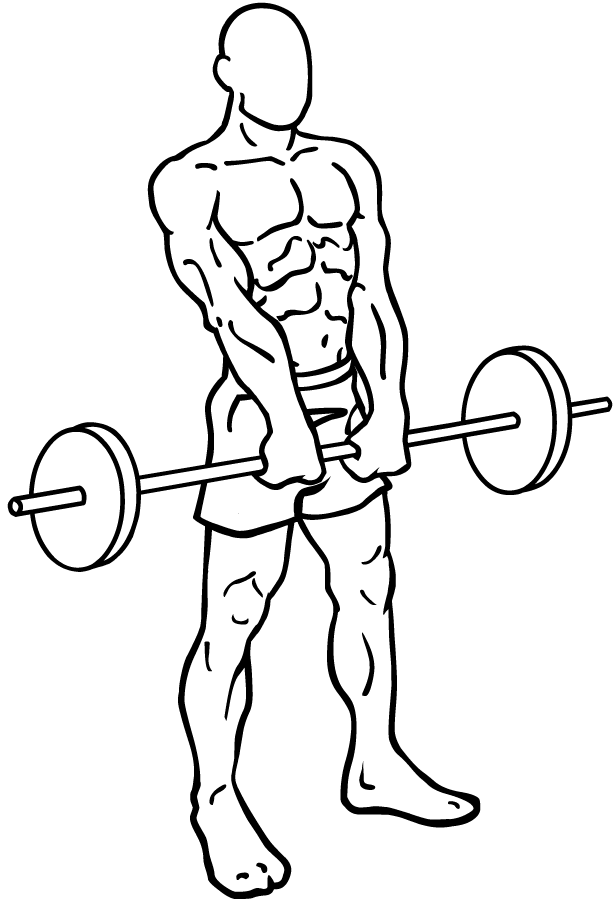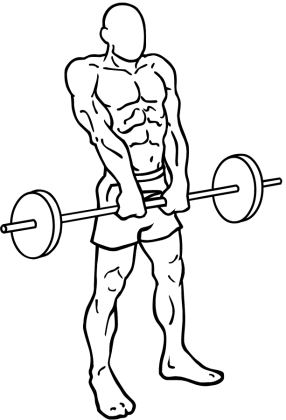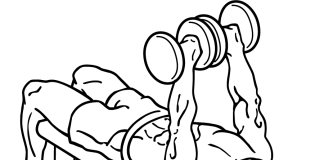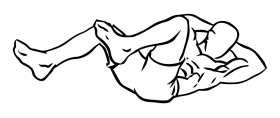Last Updated on September 25, 2014
When it comes to building a solid, well-defined upper back, the trapezius muscles are key players. The trapezius, or “traps” as they are commonly called, are a large muscle group that starts at the base of your neck, stretches across your shoulders, and runs down to the middle of your back. A well-developed set of traps not only gives you that strong, muscular look but also plays a critical role in overall shoulder and neck stability.
One of the best exercises to target and strengthen the traps is the Barbell Shrugs. While it might look like a simple movement, barbell shrugs pack a punch in terms of effectiveness. Whether you’re an athlete trying to improve performance, a bodybuilder seeking to develop an imposing physique, or just someone looking to improve posture and reduce neck strain, this exercise can be an essential part of your routine.
In this blog post, we’re going to take a deep dive into barbell shrugs, discussing the correct form, the benefits, how to avoid common mistakes, and tips for optimizing this exercise. By the end, you’ll have a full understanding of how barbell shrugs work and why you should include them in your workout plan.
What Are Barbell Shrugs?
Barbell shrugs are a weightlifting exercise primarily targeting the upper trapezius muscles. The movement is simple: you lift (or “shrug”) your shoulders upward while holding a barbell. However, the simplicity of the motion can be misleading. Many lifters neglect proper form and technique, which limits the effectiveness of the exercise and can lead to injury.
The shrugging motion in barbell shrugs is a natural movement for your traps, and when performed correctly, this exercise can help you build impressive upper back strength and size.
The Anatomy of the Trapezius Muscle
Before we jump into the steps of performing a barbell shrug, it’s important to understand the anatomy of the traps.
The trapezius muscle is a large triangular muscle that spans the upper back and neck. It is divided into three parts:
- Upper Trapezius: This is the part of the muscle that sits on the top of your shoulders and is primarily responsible for elevating the shoulder blades (shrugging). It’s the target of barbell shrugs.
- Middle Trapezius: This portion of the muscle helps retract the shoulder blades, pulling them toward the spine.
- Lower Trapezius: These fibers depress the shoulder blades and are engaged when pulling them downward.
In barbell shrugs, the upper traps are the main focus, but the middle and lower traps play stabilizing roles during the movement.
Benefits of Barbell Shrugs
Barbell shrugs are not just about aesthetics; they offer a variety of functional benefits that can improve your overall health, performance, and posture.
1. Trap Development
The most obvious benefit of barbell shrugs is their ability to strengthen and grow the trapezius muscle. Well-developed traps contribute to a thicker, more muscular appearance, particularly in the upper back and shoulders.
2. Improved Posture
Strong traps play a significant role in maintaining good posture. Many people, especially those who work at desks or spend a lot of time looking down at phones, develop rounded shoulders and forward head posture. Strengthening the upper traps can help counteract this imbalance, improving your posture and reducing the risk of neck and upper back pain.
3. Injury Prevention
Strong trapezius muscles provide stability to the neck and shoulders, which is crucial for reducing the risk of injury, especially in activities that involve heavy lifting or overhead movements.
4. Enhanced Performance in Other Exercises
Developing your traps through barbell shrugs can improve performance in a variety of other exercises. Strong traps are important for deadlifts, cleans, and other pulling movements. They also play a stabilizing role in pressing movements like the bench press or overhead press.
How to Perform Barbell Shrugs: Step-by-Step Guide
Now that we’ve covered the benefits, let’s walk through how to perform barbell shrugs with perfect form.
Step 1: Set Up Your Barbell
Start by loading your barbell with a weight you can handle comfortably. If you’re new to the exercise, start light and gradually increase the weight as you become more comfortable with the movement. Place the barbell on the floor or on a rack, depending on your preference.
Step 2: Stand in the Starting Position
Stand with your feet shoulder-width apart. Grasp the barbell with an overhand grip (palms facing down) that is slightly wider than shoulder-width. Your arms should be fully extended with the barbell hanging in front of you at arm’s length. Engage your core by pulling your belly button towards your spine, and keep your back straight and chest up.
Step 3: Drop Your Shoulders
Begin the movement by lowering your shoulders as much as possible. This will put your traps into a fully stretched position, allowing for a greater range of motion during the exercise.
Step 4: Shrug Your Shoulders
Lift (shrug) your shoulders as high as possible, aiming to bring them up toward your ears. As you lift, avoid using your arms or bending your elbows. The movement should come entirely from your traps.
Step 5: Pause at the Top
Once your shoulders reach their highest point, pause for a brief moment. This pause is important as it ensures your traps are fully engaged, and it helps prevent momentum from taking over the movement.
Step 6: Lower the Weight
After the pause, slowly lower your shoulders back down to the starting position. The descent should be controlled, not rushed. Repeat for the desired number of repetitions.
Key Tips for Performing Barbell Shrugs
While barbell shrugs are simple in theory, there are a few key tips that will help you maximize the effectiveness of the exercise and avoid common mistakes.
1. Avoid Using Too Much Weight
One of the most common mistakes lifters make with barbell shrugs is using too much weight. While it might be tempting to load up the barbell to show off, lifting too heavy can lead to poor form. When you use too much weight, you’re likely to use momentum or other muscle groups (like your arms or lower back) to help lift the bar, which defeats the purpose of the exercise. Stick with a weight you can lift in a controlled manner and gradually increase as your strength improves.
2. Do Not Arch Your Back
It’s critical to keep your back straight throughout the movement. Arching your back puts unnecessary strain on your lower spine and can lead to injury. To prevent this, engage your core and maintain a neutral spine position.
3. Focus on the Squeeze
The real magic of barbell shrugs happens at the top of the movement, where your traps are fully contracted. Focus on squeezing your traps as hard as you can when your shoulders are at their highest point. This contraction is key to muscle growth and strength.
4. Keep Your Head Neutral
Avoid the temptation to look up or down while performing shrugs. Keeping your head in a neutral position (looking straight ahead) will help maintain proper posture and prevent unnecessary strain on your neck.
5. Slow and Controlled Reps
Barbell shrugs should be performed in a slow and controlled manner. Rushing through the reps or using momentum will reduce the effectiveness of the exercise and can increase your risk of injury. Focus on smooth, deliberate movements with each rep.
Common Mistakes to Avoid
Even though barbell shrugs are relatively simple, there are some common mistakes that can limit the effectiveness of the exercise or cause injury. Here are the top three mistakes to avoid:
1. Using the Wrists to Lift the Weight
Some lifters unintentionally use their wrists to help lift the barbell. This not only reduces the work done by the traps but also puts strain on the wrists. To avoid this, keep your grip firm but relaxed and focus on lifting the weight solely with your traps.
2. Rolling the Shoulders
A popular myth suggests that rolling your shoulders during shrugs will increase the range of motion and target the traps more effectively. In reality, this movement can place unnecessary strain on the shoulder joints and doesn’t provide any additional benefit. Stick to the basic up-and-down motion.
3. Lifting Too Quickly
Shrugs are all about control. Lifting too quickly reduces the time under tension, which is essential for building muscle. Aim for a slow, steady pace, and focus on contracting your traps at the top of each rep.
Variations of Barbell Shrugs
To keep your workouts interesting and ensure balanced trap development, you can incorporate different variations of the barbell shrug. Here are a few to consider:
1. Dumbbell Shrugs
Dumbbell shrugs offer a greater range of motion than barbell shrugs, allowing you to move your shoulders in a more natural, free-form path. Additionally, dumbbells can help correct muscle imbalances between the left and right sides.
2. Smith Machine Shrugs
The Smith machine provides a fixed bar path, making it easier to control the movement. This can be a good option if you’re new to shrugs or want to focus on isolating your traps without worrying about balance.
3. Behind-the-Back Shrugs
This variation involves holding the barbell behind your body rather than in front. It places slightly more emphasis on the middle traps and can help develop a fuller, more balanced upper back.
How to Incorporate Barbell Shrugs into Your Workout Routine
Barbell shrugs can be incorporated into a variety of workout routines, depending on your goals. If your focus is on building muscle and strength, aim for 3-4 sets of 8-12 reps with moderate to heavy weight. If you’re using shrugs to improve endurance or maintain posture, you might opt for lighter weight and higher reps (15-20 reps per set).
As with any exercise, it’s essential to pair barbell shrugs with other movements to ensure balanced development. Incorporate pulling exercises like deadlifts, rows, and face pulls to target the entire trapezius muscle group as well as the surrounding muscles.
Conclusion
Barbell shrugs are a powerful exercise for building strong, well-defined traps and improving overall shoulder and neck stability. While the movement is simple, the effectiveness of the exercise depends on proper form and technique. By following the tips and avoiding common mistakes outlined in this guide, you’ll be well on your way to developing a stronger, more muscular upper back.
Whether you’re a seasoned lifter or just starting out, barbell shrugs can be an excellent addition to your workout routine. So, grab a barbell, focus on perfecting your form, and start building those traps today!









